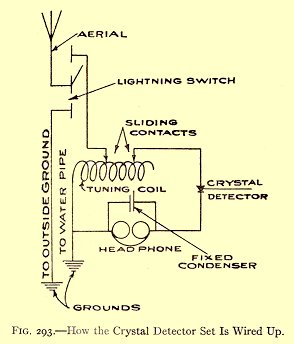Crystal Set
Today, we try to make a radio. The University of Houston's College of Engineering presents this series about the machines that make our civilization run, and the people whose ingenuity created them.
How I grooved on stories and daydreams when I was nine years old! And radio provided them. Radio gave us the words; our minds drew the pictures. That was a powerful combination.
It was rare to have more than one radio in any 1930s house, and you listened to it when your parents said you could. But listening always ended too soon. You were always called away -- to school, to supper, to chores, and to bed.
There was a way around the problem, but it was tricky. You could build your own crystal set. That was a primitive radio whose heart was a polycrystalline lump of galena, set in lead. The crystal worked as a rectifier. It served in place of a radio tube. Today, a transistor serves that function.
Once you'd made the set, you pecked away at the surface of the crystal with a fine wire probe called a cat's whisker. You eventually hit just the right facet of the crystal -- one that responded to the station you'd tuned on a homemade coil.
The signal was weak. There was no amplifier. You listened to it with earphones. But with your own secret crystal set, you'd be able to pull the covers over your head and listen to your heart's content -- after your mother had said good night. You'd be able to listen to music, or I Love a Mystery, and no one would know.
Mechanics Illustrated, or any of a hundred how-to-do-it books, all explained, in formidable detail, how to make a crystal set from hardware-store parts. But you were nine years old, and something always went wrong -- a loose wire, a badly wound coil. You never quite managed to make your own radio -- one you could play under the bed-covers. In the end, you were left reading comic books with a flashlight.
Radio permeated American life with amazing speed after its invention at the turn of the twentieth century. Here's a 1924 book, typical of the times, called The Boy Scientist. It has a twenty-eight-page chapter on radio-building.
The first section is titled, How to Make a Cheap Crystal Receiving Set. You'll have to pay two dollars for earphones. And the radio's performance will be improved if you buy a condenser to put across the headphone terminals. A finished coil can be bought for three dollars, or you can wind your own coil at the cost of about a dollar. The second section of the chapter tells how to make a better set. Cost and complexity begin adding up.
You want to scream, Stop! Even that simple set is the business of fourteen-year-olds. And you are only nine.
Making a radio was far easier to dream than it was to do. So you dreamt and wished. Of course, that wish actually came true. Today we can let Franz Schubert or Arvo Pärt wash us into slumber. But, oh, it wouldn't it've been something to've made one of those temperamental crystals sing you to sleep -- when you were nine years old.
I'm John Lienhard, at the University of Houston, where we're interested in the way inventive minds work.
(Theme music)
Collins, A. R., The Boy Scientist. Boston: Lothrop, Lee, & Shepard Co., 1925. (All images displayed or linked on this page are from this source.)
This is a greatly revised version of Episode 176.

Neil Boucher writes in to warn readers of this website about this circuit diagram from The Boy Scientist. It shows, he says, "the all too common practice of having separate grounds for lightning conductors and other devices. This is very dangerous." The diagram implicitly shows three grounds: the crystal set, the lightning rod and the household ground. "At the time of a strike to any of the grounds, all three will be at different potentials," and that can be deadly. "In fact people get shocked by using a phone during an electric storm because the grounding at the telephone switch is not bonded to the household ground (except via the earth itself). And this allows dangerous potentials to build up."
When this episode from 2002 reran on Jan. 9, 2011, I received an email pointing to a source that still provides crystal sets, a century later. see http://www.xtalman.com